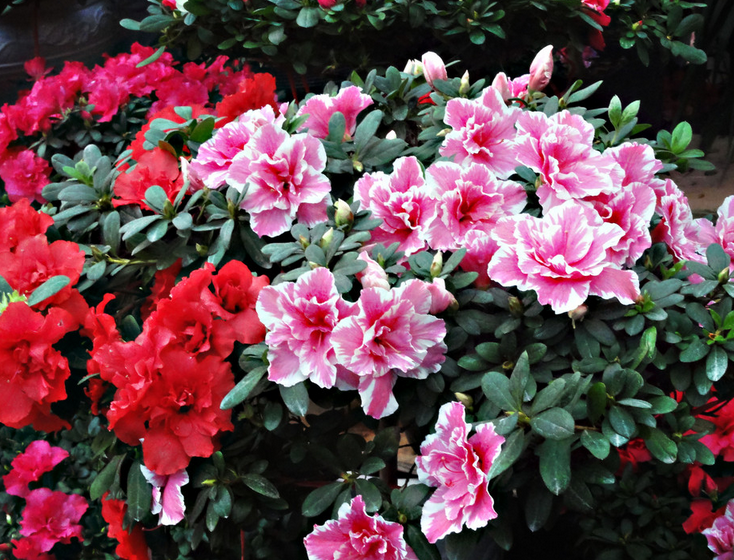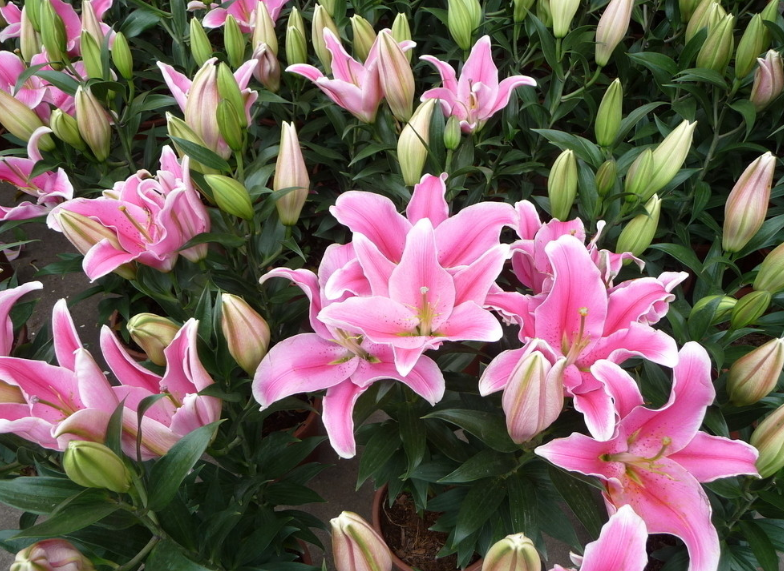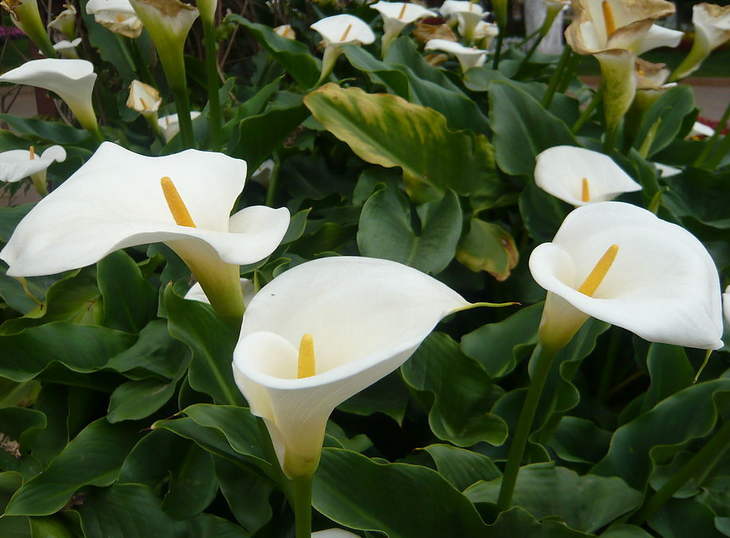Rhododendron culture method easy to cultivate rhododendron
Rhododendron is a household plant with beautiful plant shape and various colors, and it is also known as "beauty in flowers". So what should be done when rhododendrons are cultivated? Are there any methods, tricks and tricks? Next, let's learn more about it with the editor of the decoration network.

Rhododendron culture method easy to cultivate rhododendron
Culture method of rhododendron
1. Selection of flowerpots for rhododendron culture
(1) flowerpot requirements: muddy flowerpots, plastic pots, porcelain pots, pottery pots and so on can be used.
(2) the size of flowerpot: the size of flowerpot for planting rhododendron seedlings is the same as the crown diameter of seedlings, the size of flowerpot at seedling stage is 3 × 4 of its crown diameter, and the size of flowerpot at seedling stage is 1 / 2 of its crown diameter.
two。 Preparation of pot soil for rhododendron culture
Rhododendron prefers acidity (pH value 4.5-5.5), loose, well-drained soil. Avoid calcareous alkaline soil, avoid clayey soil. The formula for home cultivation is as follows: Belgian rhododendron: rotten leaf soil: peat soil: sand = 5 virtual 2vl 3; spring and summer rhododendron: garden soil: peat soil: sand = 3:5:2. Mix with proper amount of bone powder and stir evenly.
3. Temperature and light requirements of rhododendron culture
Potted rhododendrons are generally potted from March to April in spring and can also be potted in autumn. Transplant with soil when putting on the pot, and pour water into the shade after planting.
The northern potted rhododendron is generally moved indoors in the first and middle of October and placed in the sunny place after entering the house. In the early days of the room, attention should be paid to the frequent opening of windows for ventilation. The room temperature in winter should be about 10 ℃, which should not be too high, otherwise, the physiological activity of the plant will be strengthened, a large amount of nutrients will be consumed, and the flowering and growth in the coming year will be affected. At the same time, sufficient light should be given. Leave the room after the middle and late April of the following year, when the sun is softer, should be properly shaded around noon, and should be moved to a cool and ventilated place for maintenance after summer. Because rhododendron belongs to negative flowers, it needs to be maintained in the shade in spring, summer and autumn, especially in the hot sun for a long time in summer, it is easy to cause withered and yellow branches and leaves, stagnation of growth and death of the whole plant. The time of seeing light every day in autumn should be gradually lengthened, and the shading should be stopped at the end of autumn.
4. Watering method of Rhododendron Culture
Keep the basin soil moist during the growing period, need more water during the flowering period from April to June, spray water to the ground and leaves in the high temperature season from July to August, keep the air moist, cool the temperature gradually after September, gradually reduce the water content of the basin soil, and enter the dormant period in winter. Less watering should be done.
Because the root system of rhododendron is shallow, afraid of both drought and waterlogging, improper watering, light falling leaves, heavy death, therefore, watering is one of the key measures to raise juniper flowers. Watering should be determined according to the plant season and growing period. The water consumption is more in the bud and flowering period in spring, and the watering should be timely. If the pot is dehydrated, the flower will wither and the florescence will be shortened. In this period, it is appropriate to keep the basin soil moist. In summer, rhododendron branches and leaves grow vigorously, the temperature is high, and water evaporates fast. in addition to watering once a day, water should be replenished at any time. If you are a little negligent, making the basin soil too dry will cause the leaves to turn yellow, curl the leaf center, and even dry up and die.
Because the cuckoo likes to be moist, it is necessary to spray the leaves with clear water and sprinkle water on the ground around the flowerpot in summer in order to increase the air humidity and lower the air temperature. in autumn, flower buds have been formed, the temperature is dropping day by day, and the weather turns cool. at this time, keep the pot soil dry. When the temperature is low in winter, the cuckoo is dormant or semi-dormant, and the water consumption is low, so watering should be strictly controlled. Too much water is easy to rot the roots, but in this period, the branches and leaves should be sprayed with water close to room temperature every 5 to 7 days to make the plants fresh. Rhododendron watering should pay attention to the quality of water, it is more appropriate to use Rain Water, if tap water is used, it must be stored in a container for 1-2 days before use.
5. Fertilization methods for Rhododendron Culture
The roots of rhododendron are shallow and thin, and their absorptive capacity is weak, so we must grasp the principle of "thin fertilizer and diligent application" when applying fertilizer. If the fertilizer is too thick or the raw fertilizer is not fully mature, it is easy to cause rotting roots, scorched leaves and even death. Especially for 1-and 2-year-old seedlings, we should pay more attention to the amount of fertilizer, otherwise it is easy to cause fertilizer damage.
From February to March before blooming, liquid fertilizer dominated by phosphorus should be applied every 10 to 15 days to promote large flowers, and from March to April, applying the same fertilizer to summer cuckoos can make the flowers large, good color, thick petals and long flowering period. Fertilization should be stopped during flowering, otherwise it is easy to shed flowers and long leaves, which will affect the ornamental effect; after flower fade, nitrogen-based fertilizer should be applied every 10 days or so to promote new shoots. After late July, it is the period of flower bud differentiation of rhododendron. Liquid fertilizer dominated by phosphorus should be applied every 10 to 15 days to promote flower bud differentiation. No fertilizer is needed during winter dormancy, so topdressing should be stopped.
6. Pruning methods of Rhododendron Culture
Rhododendron has strong germination, many branches and dense branches. after flowering, dense branches, weak branches, withered branches, diseased branches, residual branches, cross branches and long branches should be cut off to facilitate ventilation and light. Do not cut short the reserved branches. Because the leaves of azaleas are mostly clustered at the top of the branches, a new branch and a cluster of new leaves will grow after flowering, and the old leaves will fall off immediately, and then the terminal bud begins to differentiate into flower branches in the coming year. If this branch is cut off, it will affect the number of flowers in the following year.
[rhododendron] detailed explanation of the culture method of rhododendron
Rhododendron, also known as Yingshanhong and pomegranate, is an evergreen and ordinary green shrub plant. A long time ago, it was said that there were cuckoos moaning day and night, and then causing hemoptysis and causing flowers all over the mountain to be dyed red, so they were called azaleas. Azaleas generally bloom in summer, each cluster of flowers have more than 2-6 flowers, Corolla is funnel-shaped, there are red, light red, apricot red, snow cyan, white and so on, the color is very various, but also more gorgeous. Rhododendron generally grows in mountain sparse thickets or pine forests at an altitude of 500-1200m above sea level. it is a special acidic soil plant in south-central and southwest China. Many people like azaleas, but do not know the cultivation methods of azaleas. The following editor will introduce the cultivation methods of azaleas to you in detail. [growth habits of azaleas] Azaleas are cultivated in Anhui, Suzhou, Jiangxi, Zhejiang, Taiwang, Hubei, Fujian, Hunan, Guangdong, Sichuan, Guangxi, Guizhou, Yunnan and other regions of China. It grows under mountain sparse thickets and pine forests at an altitude of 500-1200m, and it prefers to grow in acidic soil. Rhododendron likes to grow in a cool, ventilated, semi-overcast, humid and sunny environment. It is a plant that is afraid of both extreme heat and severe cold. It is suitable for growing at a temperature of 12-25 degrees Celsius, and the climate can not be higher than 35 degrees Celsius in summer. Otherwise, it will cause the new leaves to grow very slowly and be in a semi-dormant state. Shading and sun protection are needed in summer, while measures to protect against cold and warmth need to be taken in winter. It is a kind of plant that avoids exposure and likes to grow under the light of astigmatism. If the light is too strong, it will burn the young leaves and even lead to plant death. Among the ornamental cuckoos, Xijuan's cold resistance is very weak, and the temperature at 0 degrees Celsius will cause frost damage. [rhododendron culture method] Azalea generally adopts the propagation methods of cutting, grafting, striping, and so on, and cutting is taken as the main propagation method. In the case of full light, rooting is the fastest and the survival rate is very high. Generally, cuttings are carried out in spring and autumn, and the soil should be kept moist and shaded properly after cutting. First, the selection of pots: in the cultivation of azaleas, generally choose muddy flowerpots, porcelain pots, ceramic pots, plastic pots, purple sand pots. And the mud basin and purple sand basin air permeability and water permeability is very good, but also very quaint and beautiful, suitable for use. The size of the flowerpot is 3/4 of the crown diameter of the seedling, and the size of the flowerpot is 1/2 of the crown diameter after the azaleas grow up. Second, growth conditions: rhododendron is suitable for cultivation in indoor and outdoor environment, indoor environment is suitable for growing in winter, while outdoor environment can be used in spring and summer, generally using soil, but avoid cement land. It needs to grow in a spacious, ventilated and cool environment, and some protective measures can be taken, and the light transmittance of 30% is generally the most suitable. Third, soil: rhododendron likes to grow in the acid soil which is loose, permeable, drained and rich in humus, and its ph value is between 5.0 and 6.0, avoiding clay and alkaline soil. If the summer cuckoo and rhododendron are suitable for mountain soil growth, but the mountain soil should be properly cultivated. Fourth, watering: when watering azaleas, it is best to use pond water, Rain Water and river water. If it is tap water, it is best to put it for a period of time to volatilize the chlorine and then use it. You can also add 0.2% ferrous sulfate to the water and water it once a week to keep the soil acidic. Fertilization: azaleas like to grow in a cool and humid environment and need a lot of water when the flowers bloom. Enter the dormant state in winter, the need for water is not too much, can be once a week is fat and water, and then around noon is fat and water. 6. Shading: if rhododendrons are raised outdoors, they should be exposed to sufficient sunlight before flowering, but during flowering, shading should be carried out occasionally, and the light transmittance is 30%. Seventh, pruning: azaleas grow very slowly, generally pruning after flowering, to cut off long and weak branches, damaged branches, deformed branches, and so on, so that the shape is more luxuriant, watering nutrition consumption. 8. prevention of diseases and insect pests: azaleas generally encounter diseases and pests with military weight. when encountering this kind of disease and insect, you can use 40% omethoate 1500 times, spray once a week, two or three times in a row. Leaf curlers appear in the terminal buds, which can be caught manually, or sprayed with 40% omethoate 1500 times and dichlorvos 1500 times.
For more information, what does tulip stand for? what is guava? what is Camellia oleifera? the cultivation method of camphor tree price green pineapple
How to raise Rhododendron A complete Collection of cultivation methods of Rhododendron
Rhododendron, also known as mountain pomegranate, is an evergreen plant. The rhododendron cries the flowers all over the mountain red with blood, so it gets its name. Rhododendron colors are mainly crimson and light red, purple and white are also more common. When the azaleas bloom, the mountains are very bright and beautiful, which is called Flower Xishi. How to raise azaleas is better. Let's take a look at the complete collection of rhododendron cultivation methods.
How to raise Rhododendron A complete Collection of cultivation methods of Rhododendron
First, how to raise azaleas-potted rhododendrons in soil is a common method for raising azaleas at home. The soil of rhododendrons needs to pay attention to looseness and air permeability, so it is best to use soils with strong air permeability and drainage capacity. At the same time, azaleas like thin fertilizer, so it is suitable to use acidic soil plus some humus.
Second, how to raise azaleas-the growth of azaleas requires long sunshine, which requires at least six hours of sunlight in half a day, but avoid exposure all day. Azaleas in the flowering season to know how to avoid light shading treatment, with a special shading cloth is more appropriate, azaleas in the flowering stage is not suitable for exposure.
Third, how to raise azaleas-watering the roots of azaleas, so the ability to absorb water is not very strong. Therefore, azaleas should be watered frequently and quickly to ensure a wet soil environment. Outside the dormant time in winter, azaleas should be properly watered to make the flowers develop better.
- Prev

How to cultivate perfume lilies detailed explanation of culture methods of perfume lily
Perfume lily is the queen of lilies, and its petals are always so confidently open. The queen will never feel lost. Everything about her is so straightforward and direct. The editor reminds you that when you cultivate perfume lilies, you must first master some relevant knowledge.
- Next

The analysis of calla lily cultivation method helps you to easily cultivate calla lily
Calla lily is a very common flower in our daily life. Many people want to cultivate Calla lily themselves, but they don't know how to do it. A decoration network Xiaobian reminds you that when breeding calla lily, you must first master certain relevant knowledge.
Related
- Fuxing push coffee new agricultural production and marketing class: lack of small-scale processing plants
- Jujube rice field leisure farm deep ploughing Yilan for five years to create a space for organic food and play
- Nongyu Farm-A trial of organic papaya for brave women with advanced technology
- Four points for attention in the prevention and control of diseases and insect pests of edible fungi
- How to add nutrient solution to Edible Fungi
- Is there any good way to control edible fungus mites?
- Open Inoculation Technology of Edible Fungi
- Is there any clever way to use fertilizer for edible fungus in winter?
- What agents are used to kill the pathogens of edible fungi in the mushroom shed?
- Rapid drying of Edible Fungi

